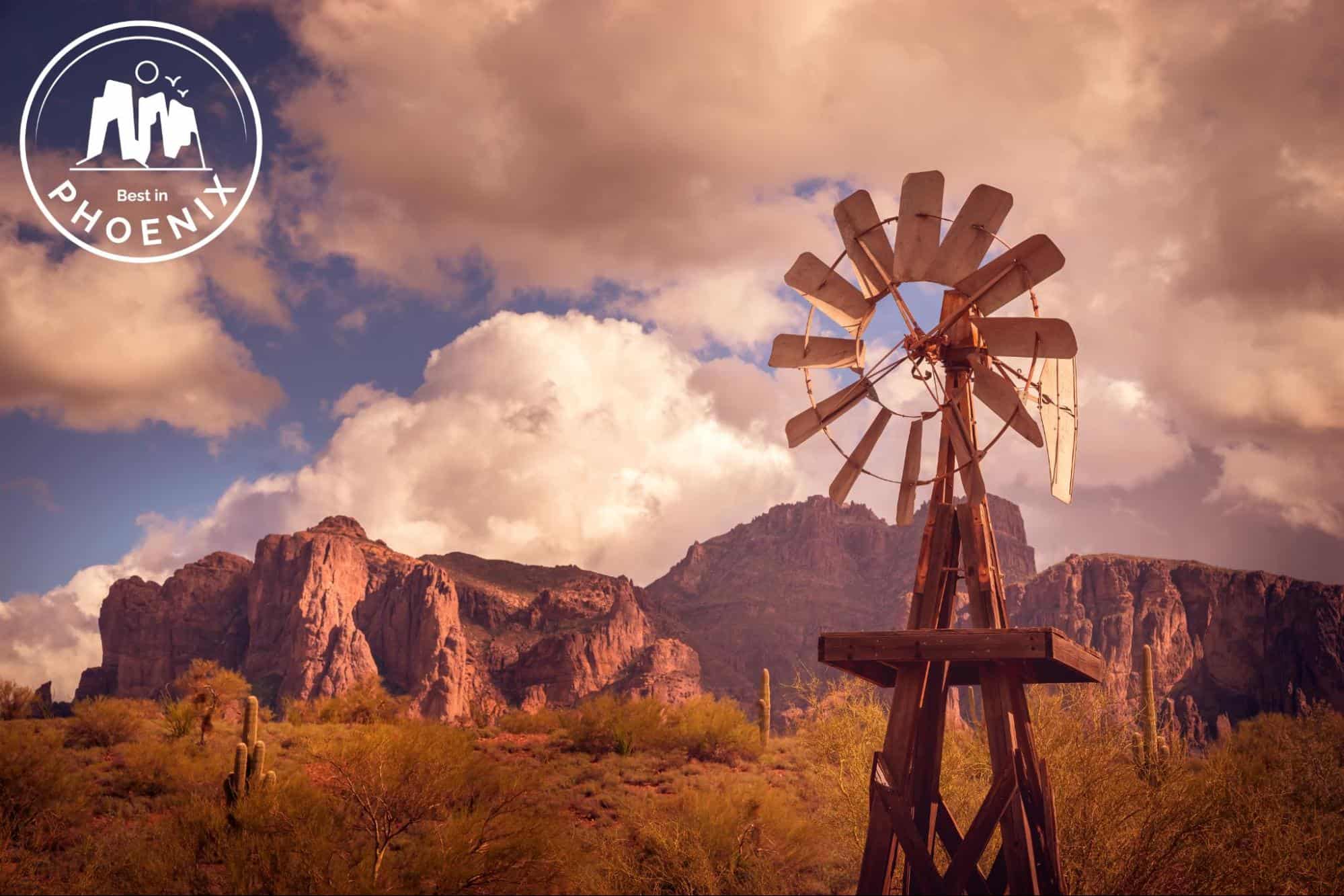Categories > Guides and Tips

Phoenix 101: The Story of the Valley of the Sun
- How and why was Phoenix founded?
- How did the city of Phoenix get its name?
- The Original Phoenix Townsite
- Phoenix Through the Centuries
- Phoenix before the 19th Century
- The Periods of the Hohokam Tribe’s Inhabitation
- The Mysterious Disappearance of the Hohokam Tribe
- Phoenix During the 19th Century
- The First Railroad in Phoenix
- The Establishment of The Arizona Republican
- Phoenix During the 20th Century
- Why did Phoenix become the capital of AZ?
- When did Arizona become the 48th state?
- Phoenix During the 21st Century
- The Collapse of the Housing Market
- The Great Recession
- Recovery from the Worst Phoenix Disasters
- The 2011 Wallow Fire
- Hurricane Rosa in 2018
- The Deadliest Summers in Phoenix
- More of Phoenix in the 2000s
- Phoenix Today
Phoenix in Arizona is one of the major cities across the United States. This sunny piece of land is home to an estimated 1.64 million people, making it the fifth most populous city in the nation.
It’s also often referred to as the Valley of the Sun because it lies flat along the Salt River Valley region. We absolutely love the sound of that slogan, by the way!
Phoenix is sometimes also called the Phoenix Metropolitan Area. This is because it comprises Maricopa County (Chandler, Glendale, Scottsdale, Gilbert, Tempe, Peoria, and Surprise) and Pinal County, (Casa Grande and Maricopa).
The metro is a great place to live in because of so many reasons – its climate, the landscape, the art, the people, and so much more.
Apart from being rich in culture, Phoenix is also rich in history. It wasn’t always the sprawling metropolis that people know today.
Read on below as we take you through the colorful and interesting timeline of the city.
How and why was Phoenix founded?
Phoenix was founded in 1868 by John W. Swilling. He was simply resting his horse at the foot of the White Tank mountains when he saw the potential of farmland across the Salt River Valley, just like the Hohokam tribe did centuries before they vanished in 1450 A.D.
The brown soil, noticeably free of rocks, was beyond the reach of frost or snow. In his mind, all it needed was water and it would be fertile land.
So, he established the Swilling Irrigation Canal Company and dug canals all over the valley. By March of the same year, crops began growing and a small colony had formed east of the land.
In hindsight, Phoenix began as a small but thriving agricultural community. But where did the name come from?
How did the city of Phoenix get its name?
The name ‘Phoenix’ was suggested by Darrell Duppa, a friend of Swilling and widely-credited as one of the early settlers in the land.
Just like how mythical phoenixes rise from their own ashes, Durell predicted that Phoenix would be a great city someday that emerged from the ruins of the Hohokam civilization.
On May 4, 1868, Phoenix was officially recognized by the Yavapai County Board of Supervisors. It was incorporated as a city in 1881 and had grown to a population of 2,500.
The Original Phoenix Townsite
In 1870, the number of early settlers and pioneers in Phoenix was rapidly growing. The people then knew that it was time for them to choose a townsite.
On October 20, 1870, a town meeting was held at the home of a certain John Moore. There, it was decided that the new townsite would cover the North Half of Section 8, Township 1 North, and Range 3 East.
Today, that townsite encompasses downtown’s business section. It’s bounded on the north through Van Buren Street, the south through Jackson Street, the east through Seventh Street, and west through Seventh Avenue.
Phoenix Through the Centuries
Let’s take a deeper dive into the history of Phoenix, looking as far back to the first settlers of today’s metropolis.
Phoenix before the 19th Century
As we mentioned earlier, the Hohokam tribe are known to be the first settlers in the Phoenix region. It is widely-believed that they lived here for over 2,000 years.
The name itself is derived from the Pima Indian (Akimel O’odham) word which means “those who have gone” or “those who have vanished”.
This was because historians and scholars were puzzled by the gap in a hundred of years of archaeological record – at which they disappeared.
They’re a tribe that had a different culture from what are usually hunter-gatherers of Indian tribes. They’re an archaic Indian tribe that moved up north and settled within the Salt River basin.
It’s believed that they migrated from Tucson and inhabited the South Mountain.
This is because the area used to be “cooler, and with greater diversity of creatures than the river basins, the South Mountains would have been an attractive place to visit for ancient desert farmers.”
They were known to be an intelligent and innovative tribe. Similar to what Swilling had seen centuries later, the Hohokam tribe saw the potential of the land they were at.
They survived by transforming what was then a dusty desert into fertile farmland. To make the Salt River Valley more liveable, they dug up and constructed irrigation canals and ditches that went as long as over 135 miles.

Image Source: Popular Archaeology
It is said that the region was the largest single body of land irrigated during the prehistoric time in North and South America, and possibly, in the world. To this day, some of the canals and irrigation systems they have built are still being used.
By 1300 A.D., the Hohokam tribe is said to have the largest population in the prehistoric Southwest. They were also believed to be the largest native population up north of Mexico City.
Historians believe that the tribe carried out trade negotiations, too, with nearby areas of Anasazi, Mogollon, and Sinagua. According to them, it was also probable that they traded with farther Mesoamerican civilizations, such as the Aztecs.
The Periods of the Hohokam Tribe’s Inhabitation
Paleontologists categorize the Hohokam tribe’s inhabitation into distinct periods – the first one being the Pioneer Period.
It is said that the Pioneer Period lasted from 1-700 A.D. It was when the tribe built shallow pit houses.
Towards the end of it, they had built the first canals that were being used for irrigation. The earliest decorated ceramics are also credited to this period.

Image Source: Joy Of Museums
The Pueblo Grande Museum and Archaeological Park actually pays homage to this period. You’ll find here remaining structures built by the Hohokam tribe that showcased their exceptional engineering skills during their time, as well as a museum with their artifacts.
Then came the Colonial Period which lasted from 700-900 A.D. This period saw the expansion of the irrigation systems, as well as the growth of their community sizes and dwellings.
Several rock arts and ballcourts are believed to have been established during this time. Cremations also became their standard form of burials.
The years 900-1150 A.D. are known as the Sedentary Period. Once again, the tribe began expanding their canals and irrigation systems.
At this point, they were constructing platform mounds and more plazas and ballcourts, especially in the larger settlement areas.
Finally, there’s the Classic Period, which is said to have lasted from 1150-1450 A.D. This is baffling to several scholars as the number of villages were believed to have declined, but remaining settlements grew in size.
The Mysterious Disappearance of the Hohokam Tribe
The Hohokam tribe mysteriously vanished sometime around 1450 A.D. The exact cause of their disappearance is unknown, but historians believe that it might’ve been the result of a drought that lasted longer than it should’ve or severe floods.
There are ongoing debates on their disappearance, as some tribes refuse to accept that they simply vanished. They believe that the Akimel O’odham/Pima and the Tohono O’odham/Papago tribes are descendants of the Hohokam tribe.
In fact, the Gila River Indian Community calls them “Huhugam,” which means “loved ones who have passed”. Cultural materials that were believed to belong to the Hohokam tribe were also found in the Hopi, Zuni, and Yuma tribes.
What’s clear, though, is that the Hohokam tribe will always be known as ahead of their time. They were exceptional farmers and engineers who built a solid foundation of what would become Phoenix today.
Phoenix During the 19th Century
The 19th century is a vital part of the history of Phoenix. As we mentioned earlier, this is the period when Swilling would create new irrigation systems and the city would see rapid growth.
After being recognized as a new town in May 1868, the first post office would be built just a month later on June 15, 1868.
Swilling was named as the first postmaster, with the office being established in his homestead.
On February 14, 1871, Governor Anson Safford proclaimed the division of Yavapai County which led to the creation of Maricopa County. The same proclamation named Phoenix as the county seat.
In May 1871, the latter proclamation was ratified and Phoenix as the county seat was approved by a set of voters. The town’s very first government is said to have consisted of three commissioners.
During the 1870s, many land lots were sold. This led to the construction of several new and prior establishments.
In 1871, the first store and church were built. A year later, the first public school class was held in the courtroom of the county building.
A small school was constructed on what is now known as Central Avenue in October 1873. And by 1875, the town had a telegraph office, sixteen saloons, and four dance halls.
In 1878, the first bank, which was a branch of the Bank of Arizona, opened in town. During the 1880s, the population of Phoenix grew to over 2,500.
With the growth of its population and architecture, it was clear that Phoenix was becoming a full-on city during this period. Here are a few other significant events in Phoenix:
- During the early 1880s, several smallpox outbreaks gave way to the establishment of the public health department
- In 1883, cotton cultivation became prevalent across the valley
- In 1885, the Arizona Canal was completed
- In 1886, a private gas lighting company and a telephone company opened shop
- In 1887, the city developed a public water system following two large-scale fires in the city (which also lead to the creation of a volunteer fire department)
- Also in 1887, a mule-drawn streetcar system was established
- In 1888, the city began to make use of electric power
- 1888 marked the founding of Peoria
- In 1889, the Arizona Improvement Company began citrus cultivation across the valley
- In 1891, the largest flood in the valley happened
- In 1892, the Phoenix Sewer and Drainage Department was created; Phoenix Indian School also held its first classes
- In 1894, Tempe was incorporated
- In 1895, the Santa Fe, Prescott, and Phoenix Railway began operations
- In 1898, the first public library and the Doris Opera House were opened
The First Railroad in Phoenix

Image Source: Tempe History Museum via RogueColumnist.com
During the 1880s, the creation of the railroad system in Phoenix revolutionized the city’s economy. The Southern Pacific Railroad extended Phoenix and Maricopa County to Tempe upon its completion in 1887.
Suddenly, Phoenix was a trade center. Goods and merchandise were flowing in and out of the city much faster through the train instead of wagons.
Phoenix then was able to reach the eastern and western markets. And because of this, the Phoenix Chamber of Commerce was established on November 4, 1888.
The Establishment of The Arizona Republican
On May 19, 1890, The Arizona Republican became a daily newspaper. It was run by Dwight B. Heard and its first editor was Ed Gill.
The name was changed to The Arizona Republic in 1930. And in 1946, the paper was bought by Eugene Pulliam, a Midwestern newspaper magnate.
To this day, The Arizona Republic remains in daily circulation as Arizona’s largest newspaper. It’s now under the ownership of the Gannett newspaper chain.
Phoenix During the 20th Century
The 20th century was a turning point not just for Phoenix, but for the entirety of Arizona as well. However, this period was met with several controversies and debates.
Why did Phoenix become the capital of AZ?
The capital of Arizona was primarily established in Prescott, then moved to Tucson. It was again returned to Prescott, and then finally, to Phoenix. Conflicts regarding the capital of the state arose as early as the 1850s.
In 1862, the Confederacy and the Union had dissenting views. For the former, Tucson was the first capital territory; for the latter, it was Fort Whipple (now known as Prescott).
However, it is widely-considered that Fort Whipple in Chino Valley was the first capital back in May 1864.
After the Civil War in 1867, the territorial capital was transferred to Tucson and would remain there for a decade. This was because Tucson then was more developed compared to its surrounding cities.
Then Governor Richard C. Mccormick was the signatory for this in the 4th Arizona Territorial Legislature. The transfer was considered to be controversial that angered many Prescott residents.
The residents believed that Gov. Mccormick’s support for the bill was his means of receiving assistance in his bid to become the Territorial Delegate to Congress. They also accused several legislature members of accepting bribes.
The accusations never presented any actual evidence. The transfer to Tucson pushed through and was seen as a way to reduce Confederate sympathy at the southern part of the region.
And at the 8th Arizona Territorial Legislature in 1875, Tucson was voted to be Arizona’s “permanent capital”. But we know now that Tucson didn’t remain as the capital.
In 1877, the 9th Arizona Territorial Legislature declared that the capital was once again transferred to Prescott. Prescott then was known to have significantly grown its political strength, having 12 representatives in the legislature of Yavapai County.
Although Prescott was a prosperous mining community, it posed logistical problems distance-wise from Phoenix and Tucson. Not only did it have harsh winter conditions, but it was also difficult to get to without railroad access.
In 1889, the legislature had decided to move the capital to somewhere more central. Phoenix, at this time, had also developed and stabilized as a city – hence, it was officially named the new capital of Arizona.
The legislature members argued that Phoenix has a better climate and that it was closer to major population centers. Further, it had a direct rail connection to the Southern Pacific Railroad and had better establishments which included restaurants and hotels.
When did Arizona become the 48th state?

Image Source: Newspapers.com
On February 14, 1912, President William Howard Taft admitted Arizona into the Union with Phoenix as its state capital. This came six months after Pres. Taft vetoed a joint congressional resolution that would grant statehood to Arizona.
After becoming a state, Phoenix’s rapid economic growth accelerated even further. In just eight years, it had grown to a population of almost 30,000.
The Heard Building, Phoenix’s first skyscraper, was constructed in 1920. And in 1929, Sky Harbor (then owned by Scenic Airways) was officially opened to the public.
Here are some more significant events in Phoenix during the 20th Century:
- In the 1920s, the original townsite was completely paved, there were 11,000 registered vehicles, and Chandler was incorporated.
- In 1921, the metro’s first synagogue, Tempe Beth Israel, was publicly opened.
- In 1922, the Valley and Gila River Banks merged.
- In 1923, the Cave Creek Dam was built and the Union Station was built.
- In 1924, the South Mountain Park, formerly known as the Phoenix Mountain Park, was created.
- In 1925, the Phoenix Fine Arts Association was established.
- In 1928, Phoenix gained access to Los Angeles through the completion of the first paved road via Blythe.
- In 1929, the Arizona Biltmore and the Orpheum Theater opened. Tourism revenue also soared to $10,000,000 for the first time.
- In 1933, the Pueblo Grande Museum Archaeological Park opened.
- In 1934, Encanto Park was opened to the public.
- Also in 1934, the popular term, “Valley of the Sun” was created and endorsed as the city’s new marketing slogan
- In 1939, the Desert Botanical Garden was opened.
- In 1946, the Arizona State Constitution was amended, granting the state to be a right-to-work state.
- In 1950, the city’s population reached over 106,000 and became the 99th most populous city across the United States.
- The 1950s saw the widespread use of air-conditioning which led to another construction and population boom.
- In 1958, Phoenix doubled in area size through annexation.
- In 1968, the city’s basketball team, the Phoenix Suns, was formed.
- In 1970, the city’s population reached 580,000, making it the 20th most populous state in the US.
- In 1975, Phoenix elected its first female mayor, Margaret Hance.
- In 1984, the Public Transportation Administration became an official department of the city.
- In 1986, the urban village divisions were created.
- In 1987, Pope John Paul II and Mother Teresa visited the city.
- In 1990, the city’s population had grown to over 980,000.
- In 1995, the Valley Metro became the first municipal bus service in the US to accept credit cards.
- In 1999, Tempe Town Lake was completed.
Phoenix During the 21st Century
Phoenix, today, continues to thrive as a multicultural metropolis. It has survived several hard-hitting events – mortgage crises, recession, crime rates, and natural disasters to name a few.
The Collapse of the Housing Market
In the early 2000s, the housing industry in Phoenix was a gold mine. Real estate agents were closing deals here and there.
Homeowners were digging deeper in their pockets to refinance mortgages and use home equity to pay for investment properties, renovations and more.
They were hiring landscape artists, architects, and general contractors. They were remodeling bathrooms and kitchens and other rooms to increase the resale value of their properties.
It was even said that during those times, if you put a house on sale in the morning, you’d have tons of offers by the time lunch time rolled around. And then, the collapse began.
From 2007-2009, the subprime mortgage crisis occurred. It was a multinational financial crisis that snowballed the prices in the housing industry, leading to a series of mortgage delinquencies, foreclosures, and devaluations of homes.
Phoenix was among the cities that was badly hit by the crisis. House prices started to decline as fast as they rose.
Homeowners began selling for lower than their asking prices. They defaulted, which led to a record-breaking number of foreclosures.
Houses across the valley saw a devaluation average of 56%, which was the third worst in the country.
Lenders and banks alike were left with massive debts. By 2008, mortgage lender Countrywide would be sold to the Bank of America and Bear Stearns would be sold to JPMorgan Chase.
In September of the same year, Washington Mutual became the largest failed bank in the United States.
Over a decade later, Phoenix has recovered. Today, the housing industry in the city is competitive and is forecasted to remain on top of the market nationwide.
The Great Recession
In December 2007, the global Great Recession happened. Banks were in debt, layoffs were happening in tides, and the unemployment rate was at an all-time high.
Arizona happened to experience some of the roughest parts of it. More than 300,000 jobs were lost – mostly ones in construction and manufacturing.
However, there was a silver lining. Technology companies popped up here and there, thriving amidst the challenge of shifting business procedures online.
Residents saw the rise of the software industry, as well as the field of renewable energy. Banks, too, underwent system overhauls that would now protect them from housing crises.
Slowly but surely, the region rebuilt its economy. And by 2016, all jobs lost during the Great Recession had been recovered.
For the first time since the recession began, Arizona had more employed people than ever. The workforce reached a record-breaking 2.7 million in February 2016, outperforming the 2.69 million workers they had eight years ago.
Recovery from the Worst Phoenix Disasters
The 2011 Wallow Fire
The Wallow Fire is Arizona’s largest fire ever in history. It was so massive that it took 41 days to be contained and smoke could be seen from space.

Image Source: NASA Earth Observatory
The fire started at Bear Wallow Wilderness area which was accidentally set off by two campers. They eventually pleaded guilty to misdemeanor charges and were ordered to pay restitution amounting to $3.7 million in November 2012.
The Wallow Fire chewed its way through 22,642 acres in Arizona and 15,407 acres in New Mexico. This is equivalent to over half a million acres of National Forest System land that included tribal, state, and private lands.
Along its path, it consumed 72 buildings and resulted in 16 recorded injuries. To this day, the restoration process of the forest is ongoing.
Hurricane Rosa in 2018
Even though Phoenix generally sees sun most days of the year, it’s not immune to water-related disasters.
In October 2018, Hurricane Rosa barreled through Arizona and drenched parts of Phoenix. Severe warnings for flash floods were issued and the water quickly flooded freeways, trapping some citizens in their cars.
According to the National Weather Service, more than 2 inches of rain fell and more was expected by midmorning. It’s known as one of the wettest Octobers that Phoenix had ever experienced.
Firefighters carried out several rescue operations to get the people who were stuck in their vehicles. Waist-deep, muddy water made the ordeal much harder amidst the heavy downpour of rain.
Flood warnings were in effect until midafternoon for parts of Southern Arizona. At least six roads were also closed in Tucson because of flash floods.
Hurricane Rosa made residents realize that not only should they be prepared against heat-related disasters, but against monsoons as well.
The Deadliest Summers in Phoenix
In 2020, nearly 200 people died from heat-related injuries in Phoenix. It was known as the “hottest, driest, and deadliest” summer the city ever had.
Phoenix residents may be accustomed to the hot climate, but the past years have seen a dramatic increase in the city temperature.
In October of this year, the Maricopa County Department of Public Health released their heat death report for 2021. A record-breaking 339 people died from heat-related injuries – the highest toll since 2006.
These days, residents are doing preventive measures from any heat-related injury. Proper HVAC units are a must in the city, as well as keeping hydrated and staying indoors during heat waves.
More of Phoenix in the 2000s
The 2000s also saw many events that shaped Phoenix today. Below are a few of them.
- In 2001, the Arizona Diamondbacks won against the New York Yankees in the World Series.
- In 2003, construction of the Metro Light Rail began.
- In 2005, America West and US Airlines merged which created the fifth-largest airline in the US
- In 2006, the Phoenix Metropolitan Opera and Phoenix Art Museum expansion were founded.
- In 2007, the Phoenix Mercury won the Women’s National Basketball Association championship
- In 2008, the Valley Metro Rail began its operations.
- In 2009, the Phoenix Civic Space Park opened and the Freeport-McMoRan Center was built.
- In 2010, the Phoenix Musical Instrument Museum opened. It’s the largest museum of its type in the world.
- Also in 2010, the Phoenix population grew to 1,445,632; while the Phoenix Metropolitan Area had 4,192,887 residents
- In 2012, the CityScape building was constructed.
- In 2017, a heat wave grounded over 40 airline flights.
- In 2022, Phoenix’s population is estimated to have ballooned to 1,640,641; while the Phoenix Metropolitan Area is at 4,652,000.
Phoenix Today
Despite everything, the city rises and overcomes. Even though it’s best known for its desert-like climate, it’s also a top destination for outdoor adventures, nightlife, job opportunities, education, and more.
When it comes to hiking destinations, Phoenix has no shortage of it. And, you can even take your pick among various difficulty levels.
In the mood to go kayaking or paddle boarding? There are several parks smack in the middle of the city where you can make a day out of it.
On Friday nights (or any other day of the week, for that matter), take a walk downtown or along Roosevelt Row for drinks, good food, and art appreciation.
It’s no wonder that people across the country are moving to Phoenix. It’s a city that offers pretty much everything one would be looking for – great sunsets and scenic palm trees are bonuses, too!





